Most consumers view fast-food advertising with a grain (or whole packet) of salt: The mouth-watering presentations we see on TV rarely resemble what we find at the bottom of our greasy paper bags. And even though fast-food ads are unrealistically appetizing, they remain alarmingly effective.
Recent studies suggest teens exposed to more junk food commercials are more likely to overeat and struggle with obesity. Some experts even charge that fast-food brands are taking a page out of the Big Tobacco playbook from decades past, inundating consumers with attractive images to obscure health concerns.
Which fast-food brands have advertisements that are furthest from the food we actually get? To find out, we asked more than 500 individuals to compare real pictures of fast-food items against their depiction in ads. Our findings illustrate which fast-food giants are most effective at presenting appetizing food regardless of reality. To find out which chains advertisements most resembled reality, keep reading.
Arby's
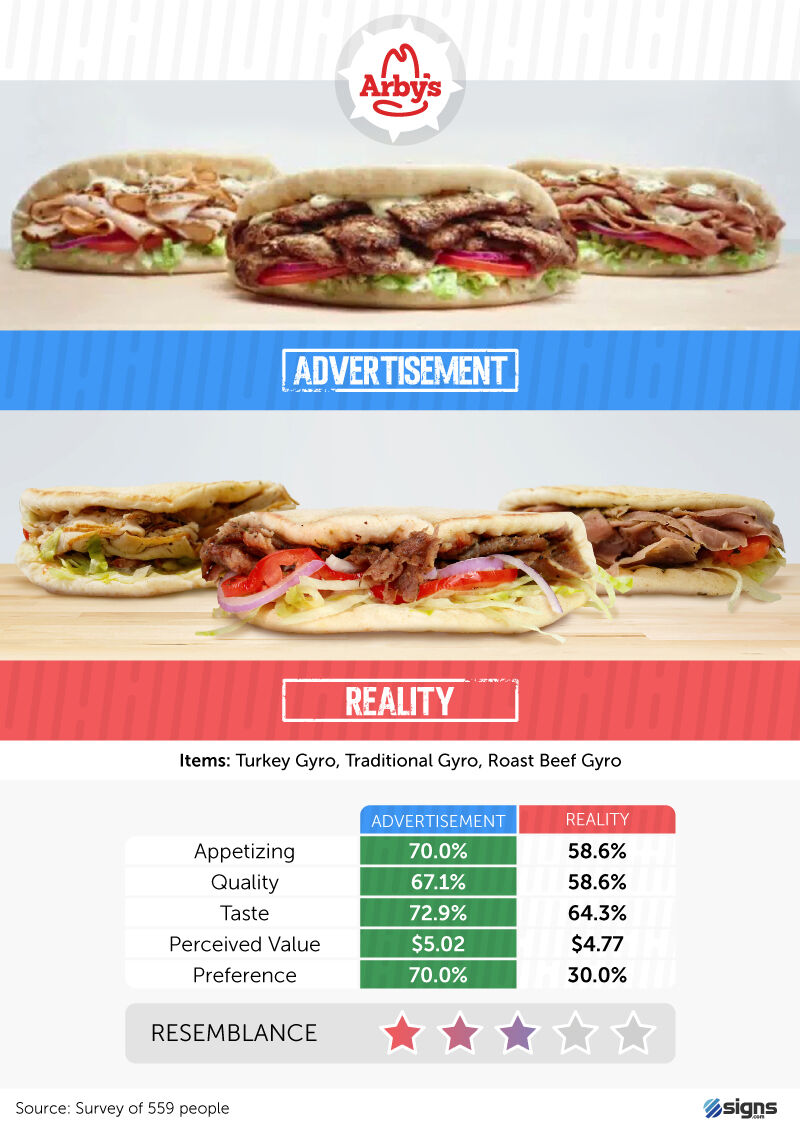
Commitment to carnivores is a basic tenet of Arby's advertising: the brand even adopted the slogan "We have the meats" to hammer the point home. But when they compared real product images to advertisements, many respondents were left wondering where the meat was. While the ad scored 70% for appetizing, the real items scored less than 59 percent. Additionally, our data suggested consumers would pay roughly a quarter less for the actual item on average. In terms of resemblance to reality, respondents gave the ads just three stars out of five. While that might seem like a middling score, you'll find that many other brands performed far worse as we move on.
Burger King
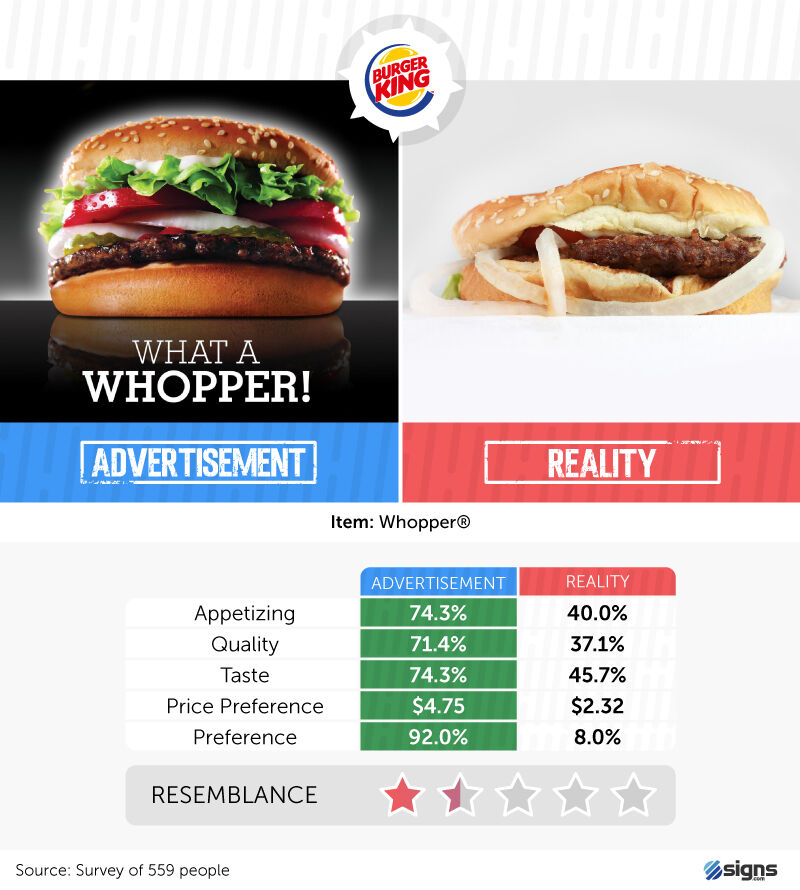
Relative to its ad presentation, the famous Whopper proved entirely underwhelming. The real picture of the burger scored less than 50 percent in the appetizing, tasty, and quality categories. Perhaps more concerning for the brand, the average value respondents placed on the real Whopper picture was less than half what they'd pay for the burger as advertised. Despite the dissatisfaction apparent in our data, the Whopper continues to be a pillar of Burger King's business model. The company claims to sell over 2.1 billion Whoppers annually, far outpacing McDonald's Big Mac.
Carl's Jr.
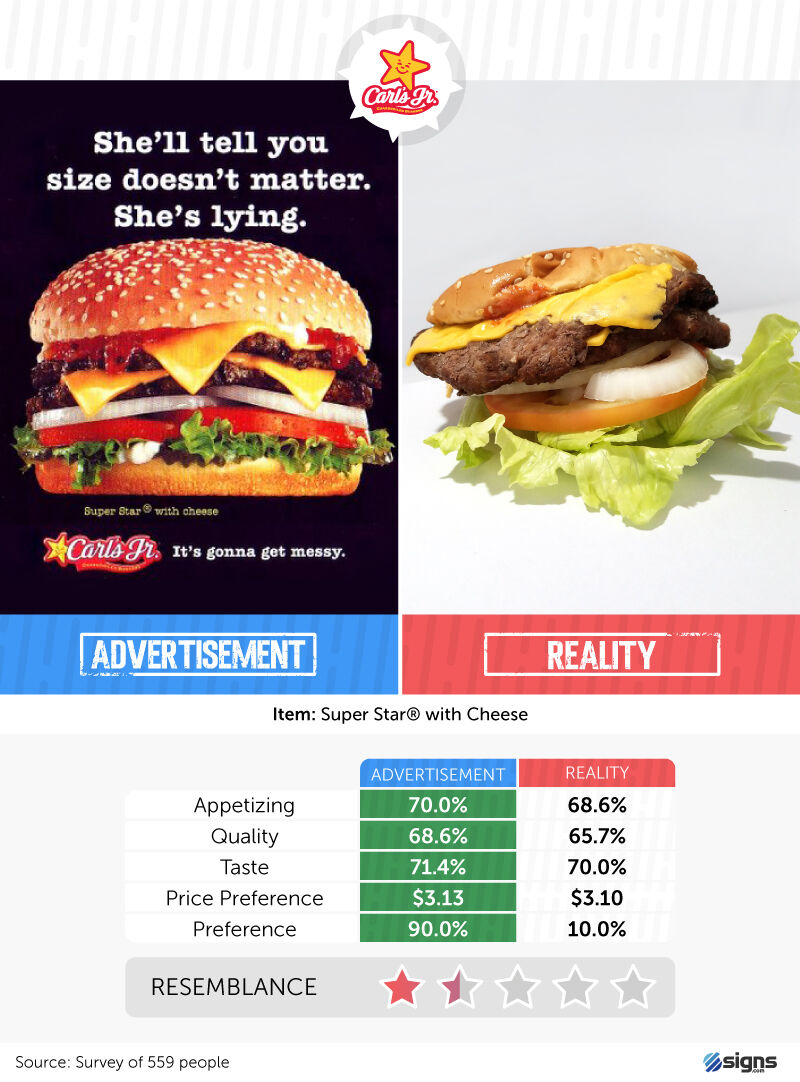
When it comes to marketing, Carl's Jr. is better known for controversy than veracity: The brand's ads previously featured scantily clad models on a consistent basis.. But as far as the perceived qualities of their Super Star burger, advertising and reality corresponded closely. Respondents said they'd pay nearly the same amount for the burger featured in the ad and the one in the real-life picture. These findings don't mean the ad was accurate, however; it earned just 1.5 stars for resemblance from our respondents. It seems that the real Super Star is about as appealing as the one presented in the photo, until the two are compared side by side.
Chick-fil-A
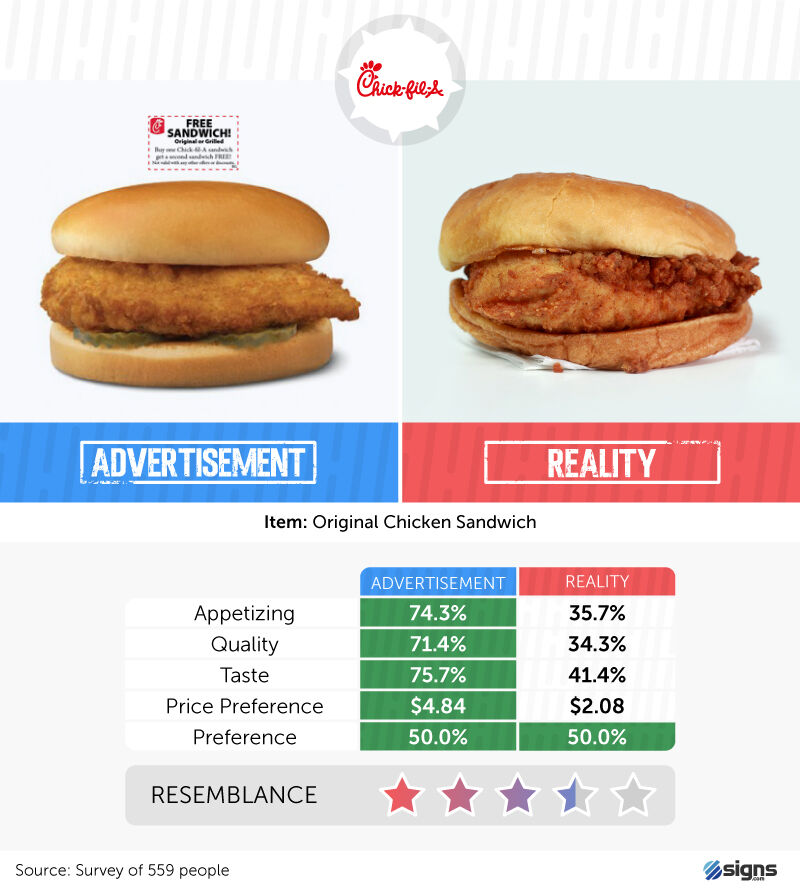
Chick-fil-A has built a devoted following in recent years and expanded swiftly as a result. Yet, the strictly chicken chain struggled when we juxtaposed a real image of its most famous sandwich against an ad. While more than 70 percent of respondents found the advertisement appetizing, tasty, and high quality, reactions to the real picture were dramatically less enthusiastic. Additionally, respondents would pay less than half as much for the real sandwich on average. Still, the true chicken sandwich must have some devoted proponents, as 50 percent said they'd prefer the real thing over the advertised image.
Chipotle Mexican Grill
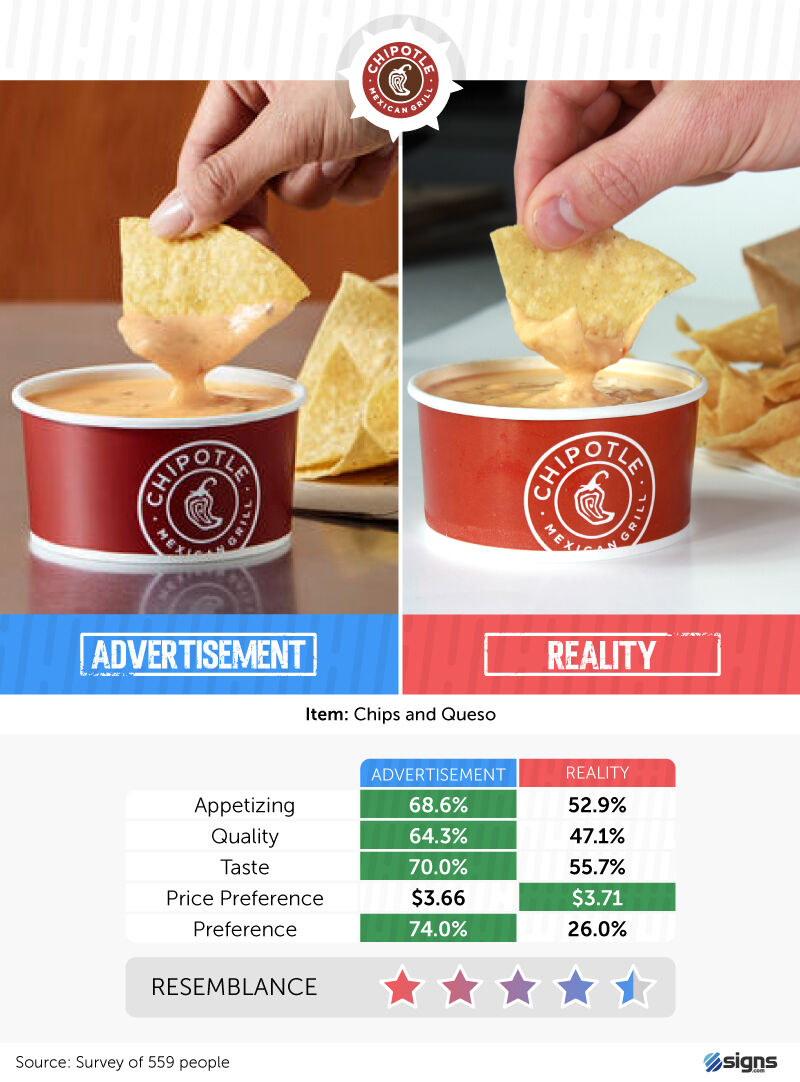
Chipotle has had its queso-centric struggles. The brand's buzzed-about rollout of the cheesy dip in 2017 generated harsh criticism from customers. As far as advertising accuracy, however, our respondents gave the queso images high marks, rating the ad's resemblance to the real product at 4.5 stars. Interestingly, however, respondents still perceived the dip to be far less appetizing and lower quality in the real image of the item. This finding suggests that subtle differences in color may yield major differences in perception among customers – in the ad, the queso appears to be a slightly richer yellow.
Domino's Pizza
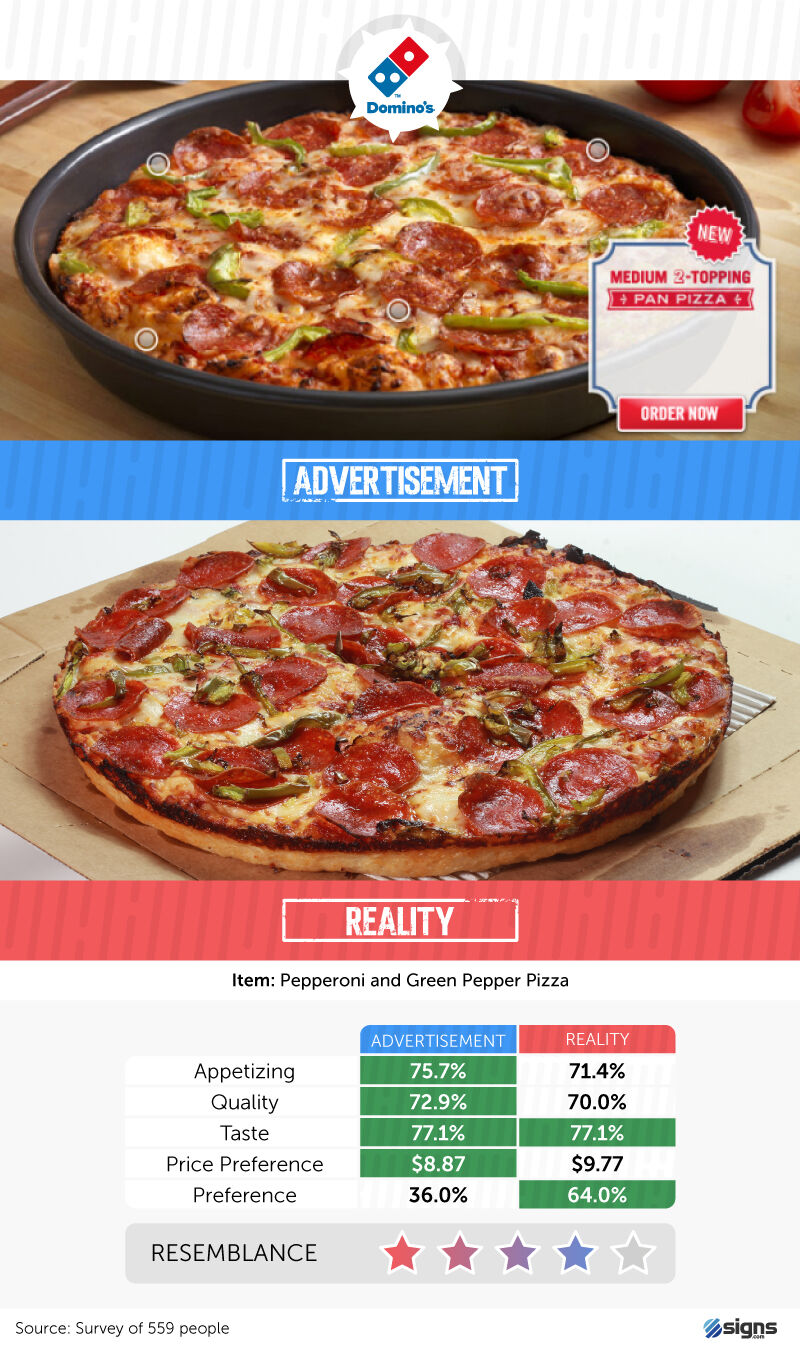
Domino's is often lauded for its rebranding efforts after a torrent of consumer complaints in 2008, the pizza giant embraced a transparent approach to improvement, acknowledging its quality issues in national ads. The brand has apparently succeeded in making strides since then because it was one of just two chains for which respondents actually preferred the real-item picture. Moreover, they were willing to pay about 90 cents more for the real image.
Five Guys
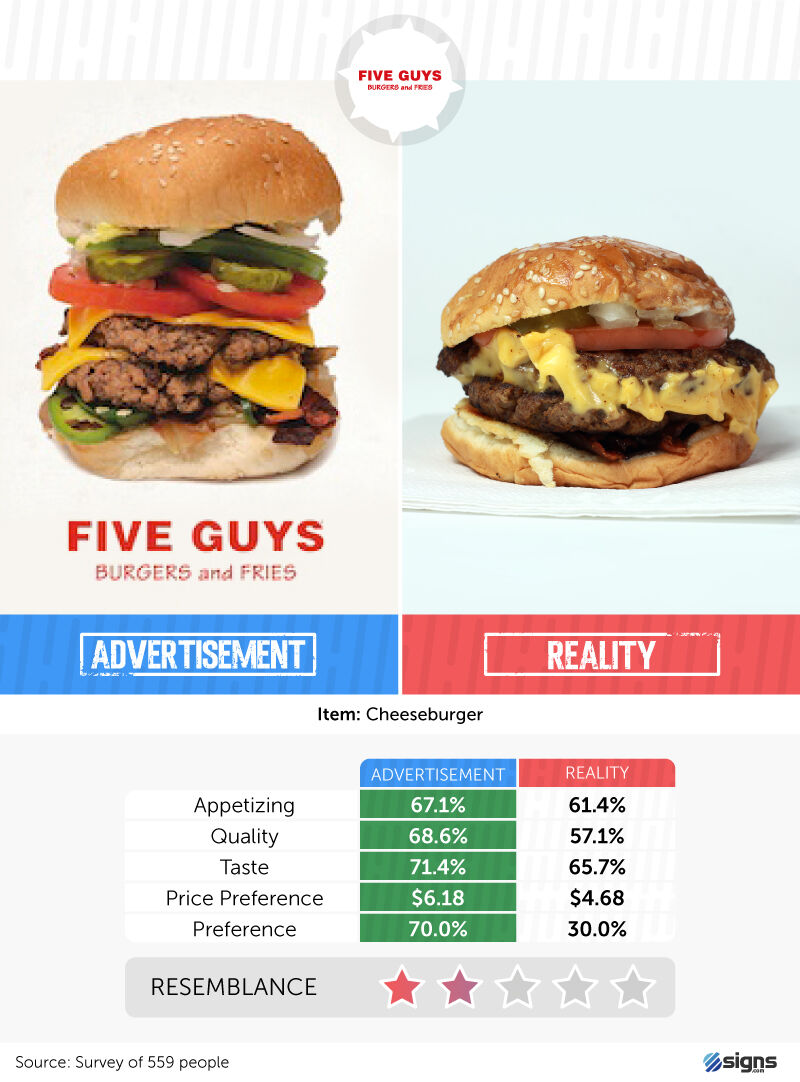
When comparing a real picture of the Five Guys cheeseburger to the advertised version, it's hard to miss the height differential. Perhaps because the true burger is shorter than the ad implies, respondents rated the resemblance just two out of five stars on average. Additionally, they felt the real burger was worth $1.50 less than its airbrushed counterpart. However misleading the ad may be, it seems Five Guys patties deliver in reality. The chain was recently voted America's favorite burger, unseating the next brand we studied, In-N-Out.
In-N-Out Burger
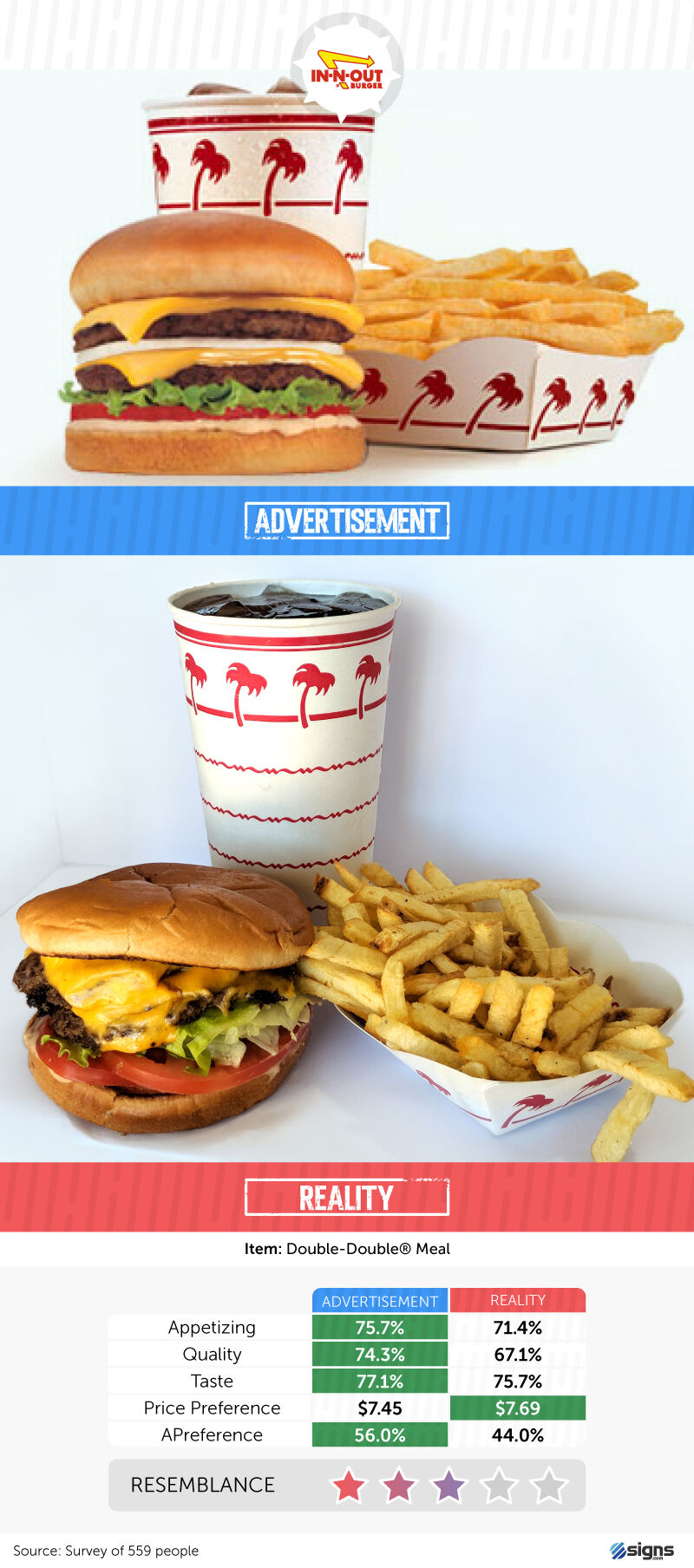
The Double-Double held up well against its advertised self, earning only slightly lower scores in the perceived appetizing, quality, and taste categories. In fact, respondents said they'd spend slightly more cash on the real deal ($7.69) than the advertised version ($7.45). These findings should feel encouraging for a chain that has refused to compromise on quality. All the chain's locations are "within 300 miles of its patty-making facilities," and the company has resisted establishing East Coast outposts that would need to use frozen burgers instead.
Jimmy John's
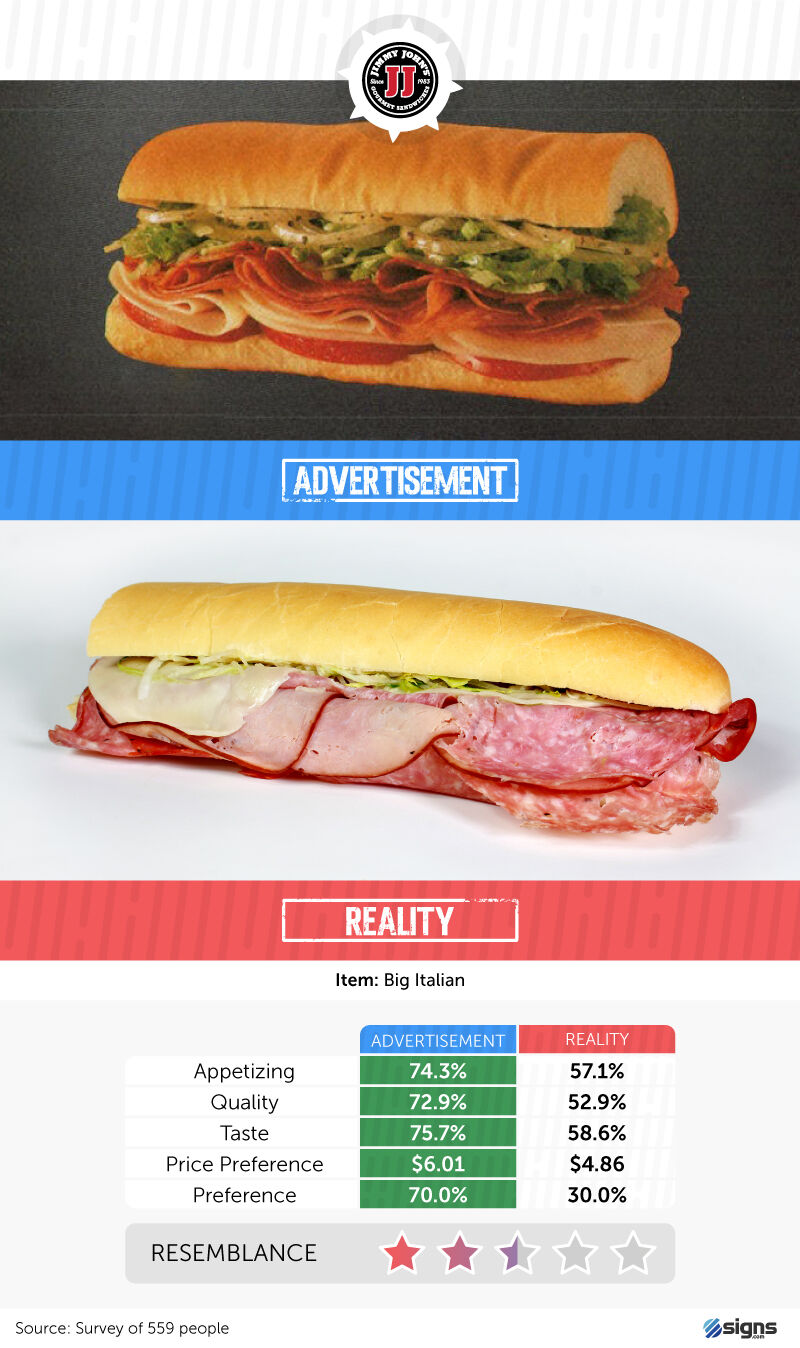
Call it a classic case of meat overflow: While the Jimmy John's ad presents all sandwich ingredients in perfect proportion, the real image reveals meat hanging well outside the bread. Perhaps that's why respondents gave the real-life item poor marks compared to the advertised product: Regarding the appetizing, quality, and taste variables, the actual sandwich scored at least 15 fewer percentage points. The value estimated reflected these opinions as well. Respondents were willing to pay more than a dollar more, on average, for the advertised version of the Big Italian.
KFC
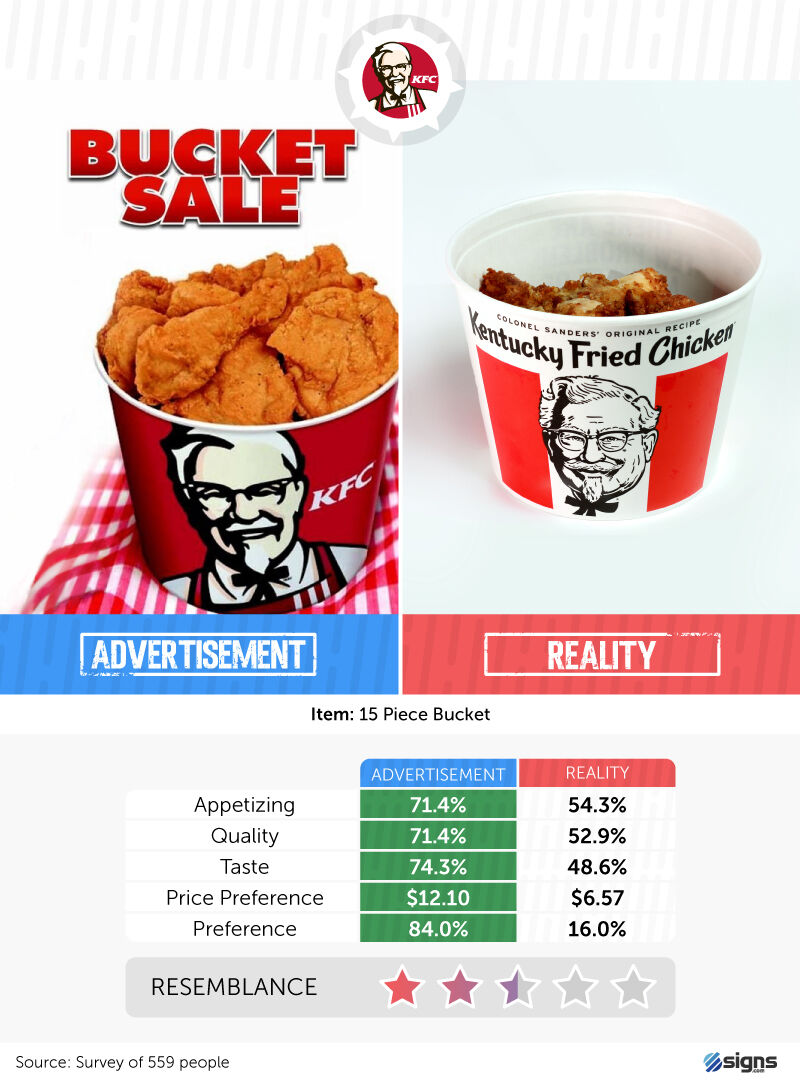
Sure, the golden crispy quality of KFC's ad looks far more "finger lickin' good" than the real item, and our respondents' scores reflected that glaring gap in appearance. But the most compelling statistic to arise from this comparison was the differential in estimated price. Whereas people would pay over $12 for the overflowing bucket of the ad, they thought the real product was worth just $6.57. Half a world away from Kentucky, however, consumers seem content with the company's offerings: KFC is now the biggest fast-food chain in China.
McDonald's
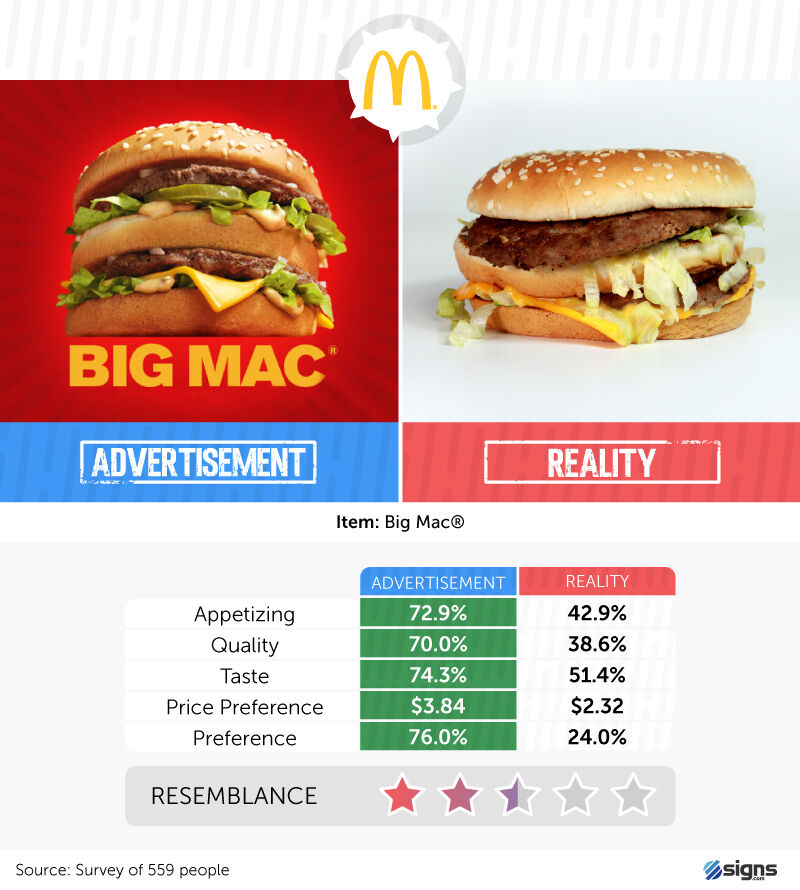
Created more than 50 years ago, the Big Mac is one of the most recognizable names in the pantheon of fast-food classics. Unfortunately, most respondents found its current manifestation lackluster; the real product picture scored less than 50 percent in the appetizing and quality categories. Additionally, they valued the real Big Mac at $2.32 on average, whereas they said the advertised version was worth $3.84. While these reservations are understandable, sales figures say the Big Mac's appeal remains strong. It's the second-best-selling item of all time on the menu - behind french fries, of course.
Moe's Southwest Grill
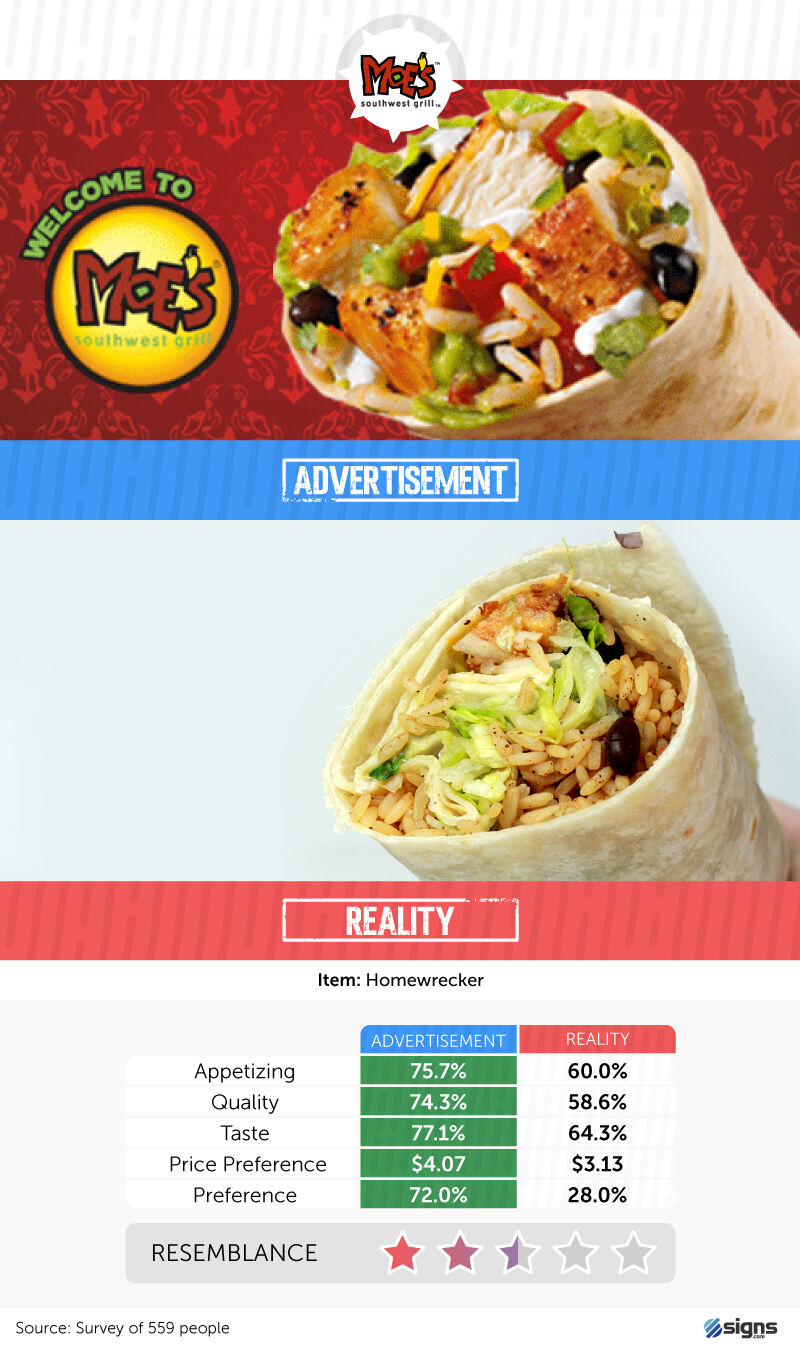
In its unadorned form, Moe's Homewrecker burrito is a far less colorful affair. Accordingly, whereas the ad version scored in the mid-70s, the real image only garnered an appetizing score of 60 percent. Perceived quality was much lower for the real item as well; it scored less than 59 percent. Still, a substantial group of consumers must find the company's offering delectable: the chain was recently voted the nation's most-beloved Mexican chain, beating out heavyweights such as Chipotle and Taco Bell.
Panera Bread
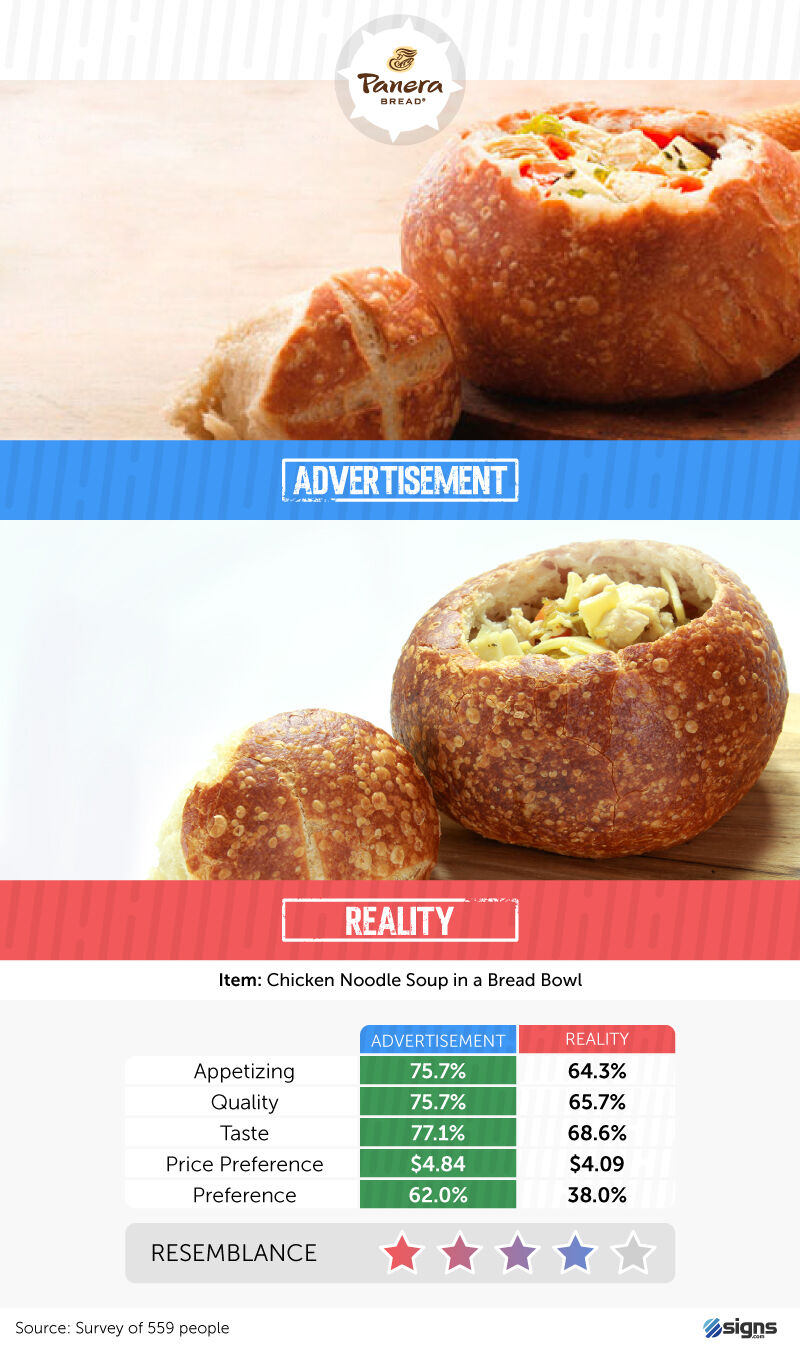
Employing bread as a bowl may be a surefire way to woo some consumers, but Panera's ad surpassed the real photo in several measures of appeal. The advertised version scored in the mid-70s for appetizing, quality, and taste, but the actual photo was less likely to receive such compliments. Understandably, then, the estimated price for the advertised image was 75 cents higher. On the other hand, respondents had a relatively high opinion of the ad's accuracy, rating it four of five stars for resemblance.
Papa John's Pizza
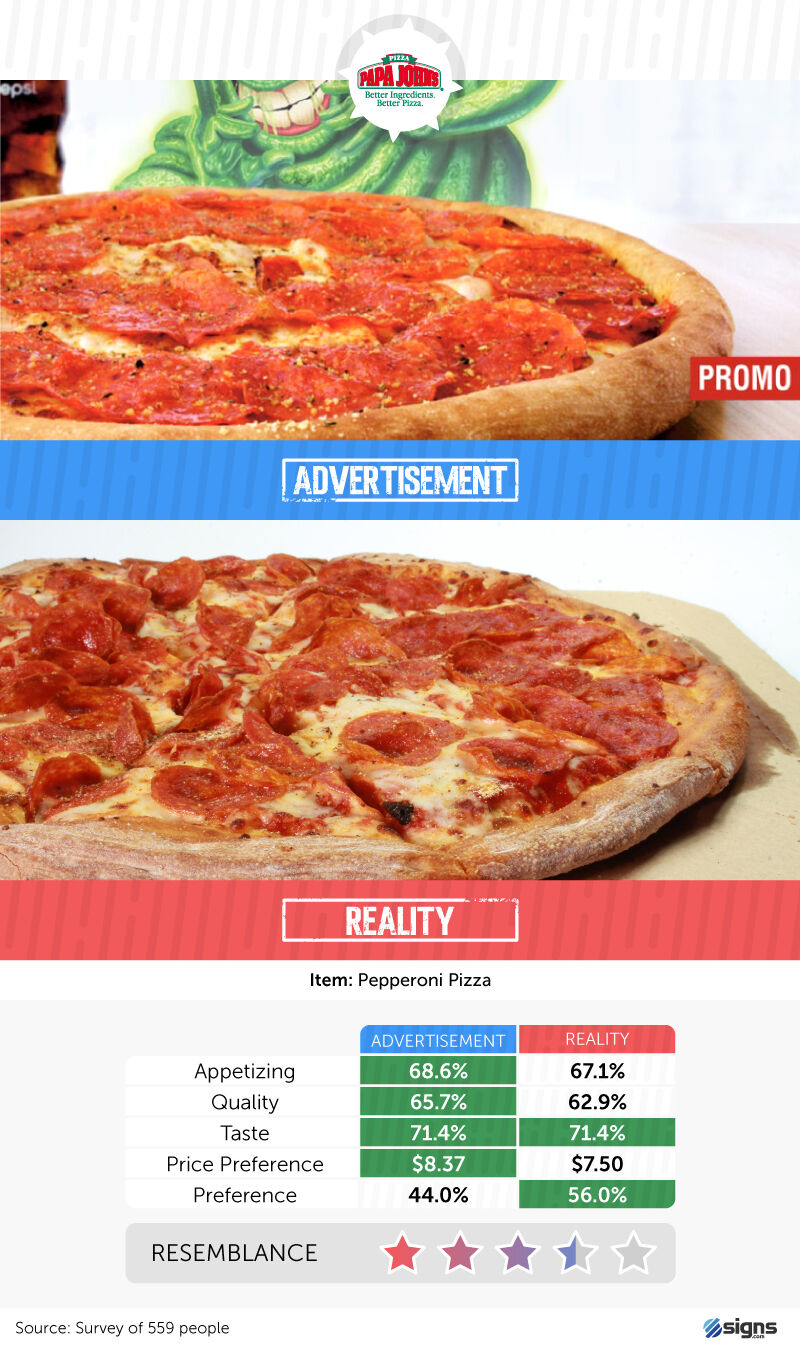
Perhaps pizza advertising is especially difficult. Just as we found with major competitor Domino's, a majority of respondents actually preferred the real image of a Papa John's pie to the advertised version. To be fair, the advertised image wasn't completely off-putting: it was actually slightly more likely to seem appetizing and high quality. Moreover, respondents typically thought the advertised version would cost more – perhaps something about the real pizza's crispiness spoke to our respondents. By contrast, the version in the ad appears relatively doughy.
Pizza Hut
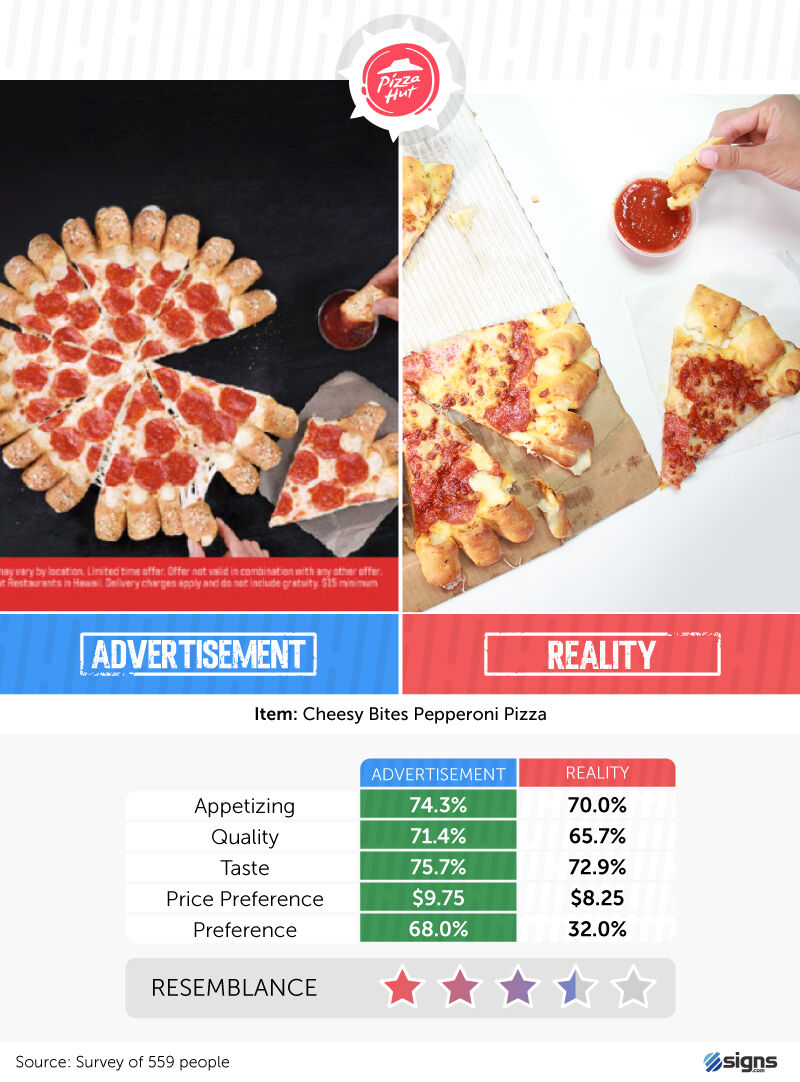
Unlike its pie-slinging competitors, Pizza Hut made its ad images more appealing than its real-life product. The gap wasn't enormous, however: On perceived quality, tastiness, and appetizing appeal, the real pizza photo was just a few percentage points behind the advertised version. The cheesy bites arrayed around the pizza's edges are a fan favorite, re-introduced each summer since their launch in 2006. Actually, Pizza Hut stands apart from other chains as a crust innovator. Its "Stuffed Crust" pizza is a classic of the genre as well.
Quiznos
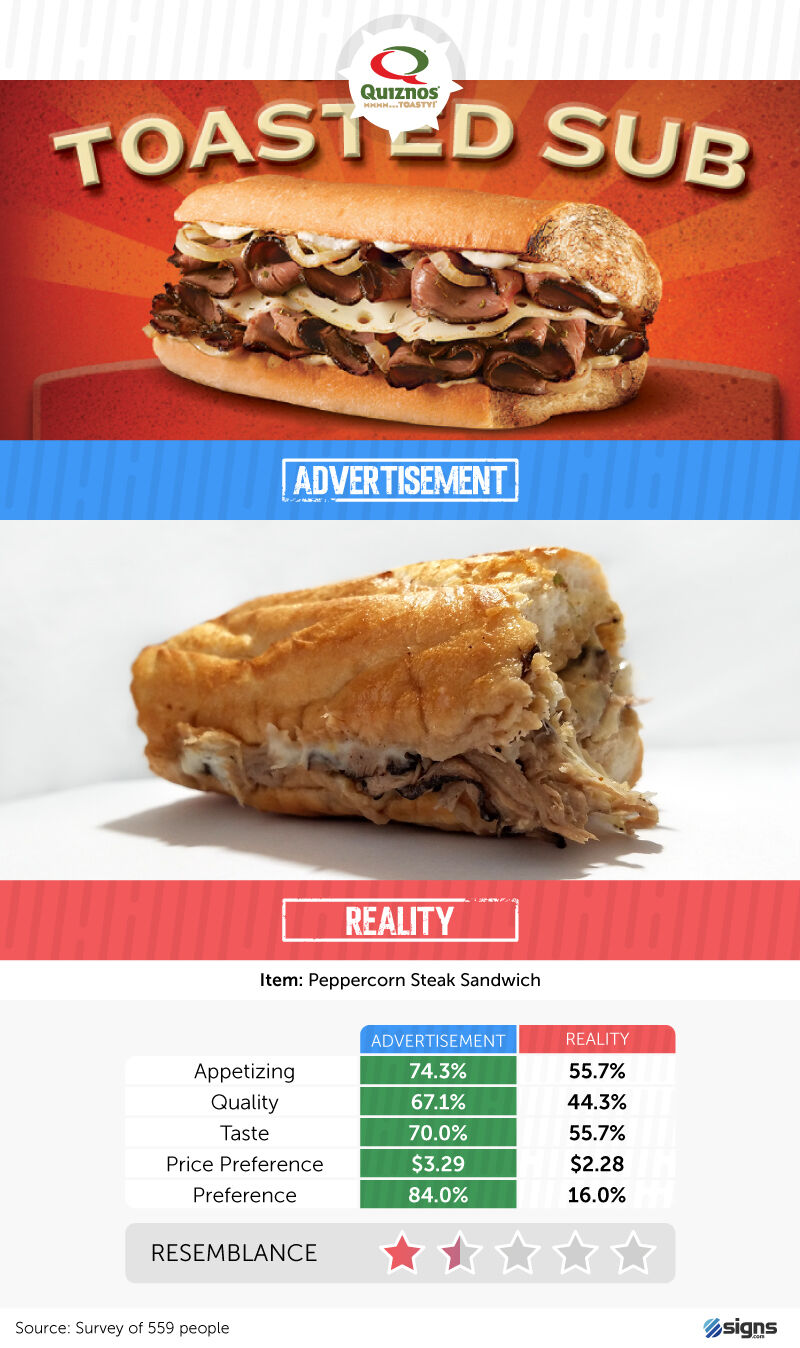
Quiznos has struggled in recent years, shrinking from 5,000 stores in its heyday to just 800 locations in 2018. That trend could be attributable to the actual appearance of its sandwiches, which seemed substantially less appetizing, lower quality, and less tasty to our respondents. Perhaps the "toasted" quality of the sub seemed lacking in reality; compared to the advertised version, the real sub appears somewhat soggy. Indeed, respondents gave the resemblance between the ad and actual item just 1.5 of 5 stars.
Shake Shack
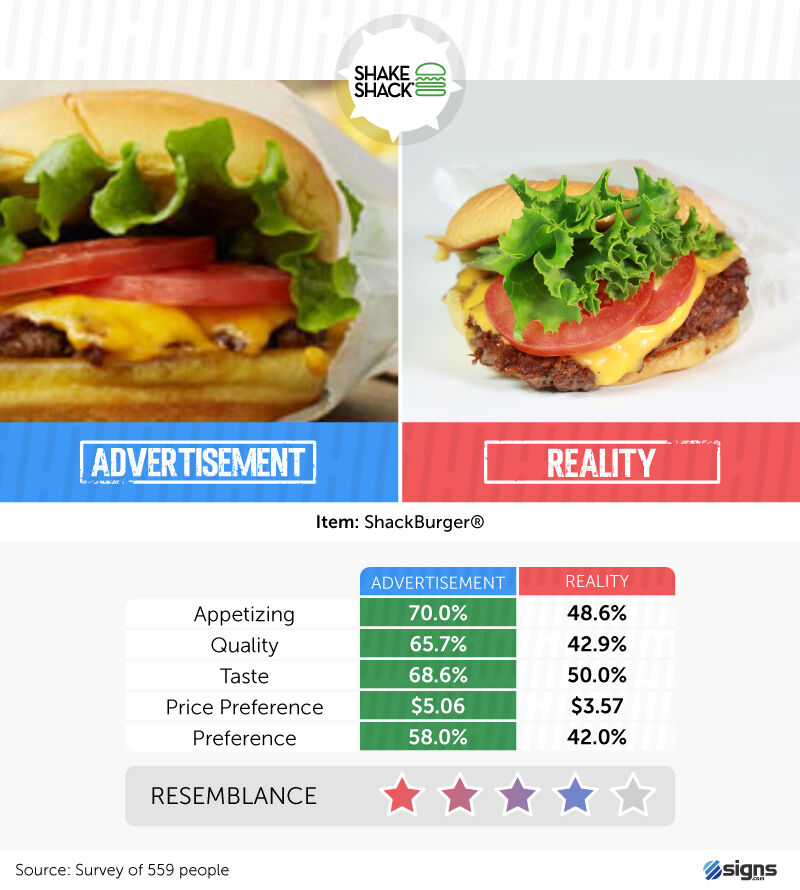
Our respondents' assessments of Shake Shack seemed somewhat contradictory. On the one hand, the fast-casual brand earned high marks for the resemblance between its ad and actual burger. Yet, the real image scored less than 50 percent in appetizing or quality and only a few percentage points more for taste. The brand's biggest issue, however, might be the perceived value of its product. Shake Shack's burgers cost far more than the $3.57 our respondents said they would be willing to pay for the real product.
Subway
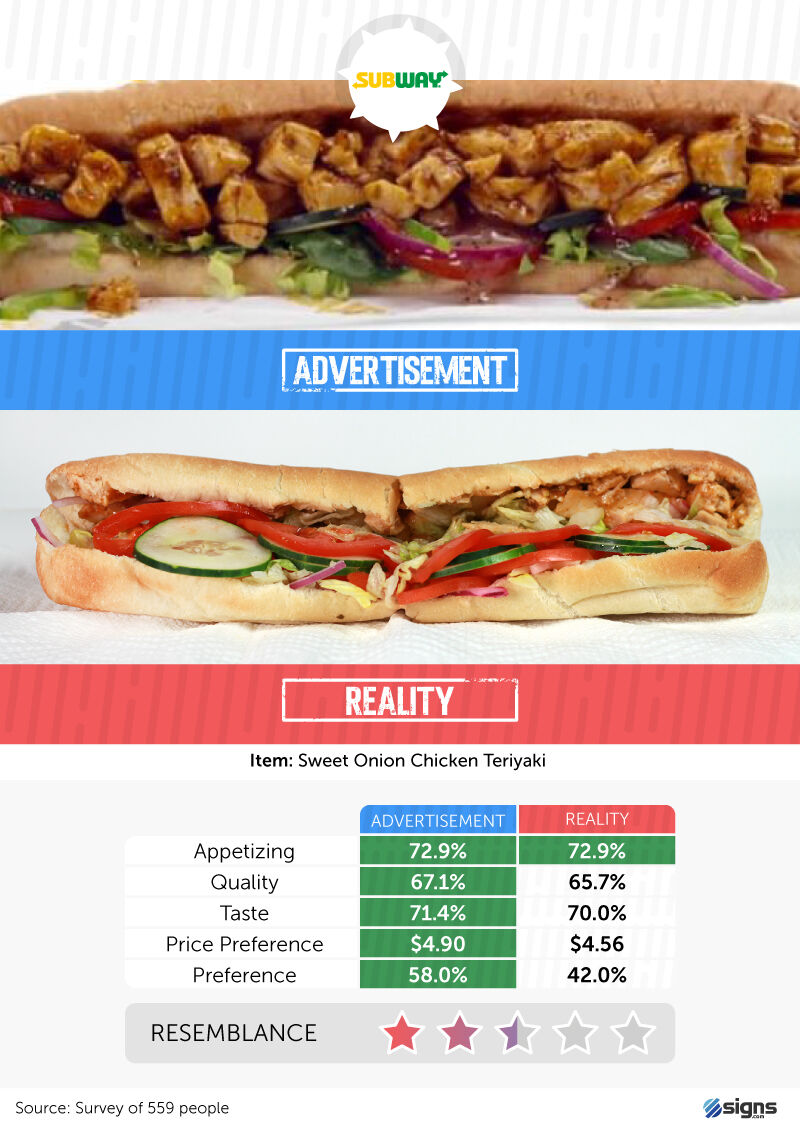
Real images of Subway sandwiches didn't lag far behind their advertised versions: On quality, and taste the undoctored images were just a few percentage points lower and they tied for appetizing appeal. Still, most people preferred the advertised image, in which a surplus of meat and sauce seems ready to spill out from the sandwich. Interestingly, respondents said they'd pay less than $5 for either version, a potential pricing problem for the chain. Although the brand was once synonymous with the "$5 footlong," each franchise owner can now decide whether to offer sandwiches at that low price.
Taco Bell
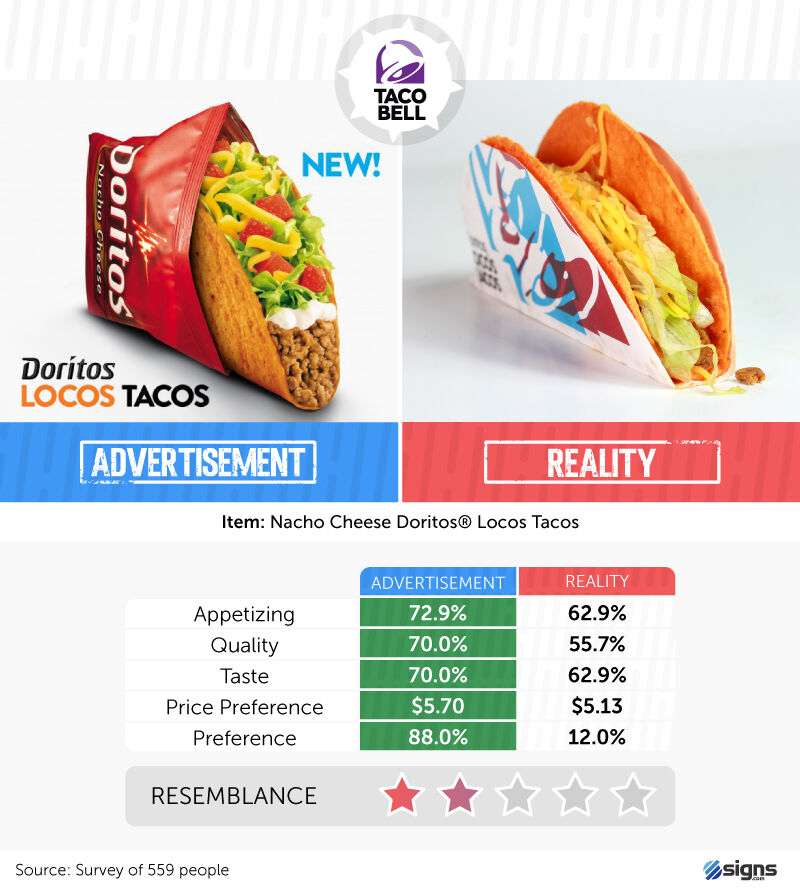
It would certainly be impressive if each Doritos Locos Tacos boasted the neatly layered ingredients visible in the advertised image. But the real image seemed particularly dilapidated in comparison, and respondents gave it just two of five stars regarding its resemblance to the ad. Similarly, the undoctored image scored a low percentage for its perceived quality. Interestingly, however, respondents said they'd be willing to pay much more for the taco than it actually costs.
Wendy's
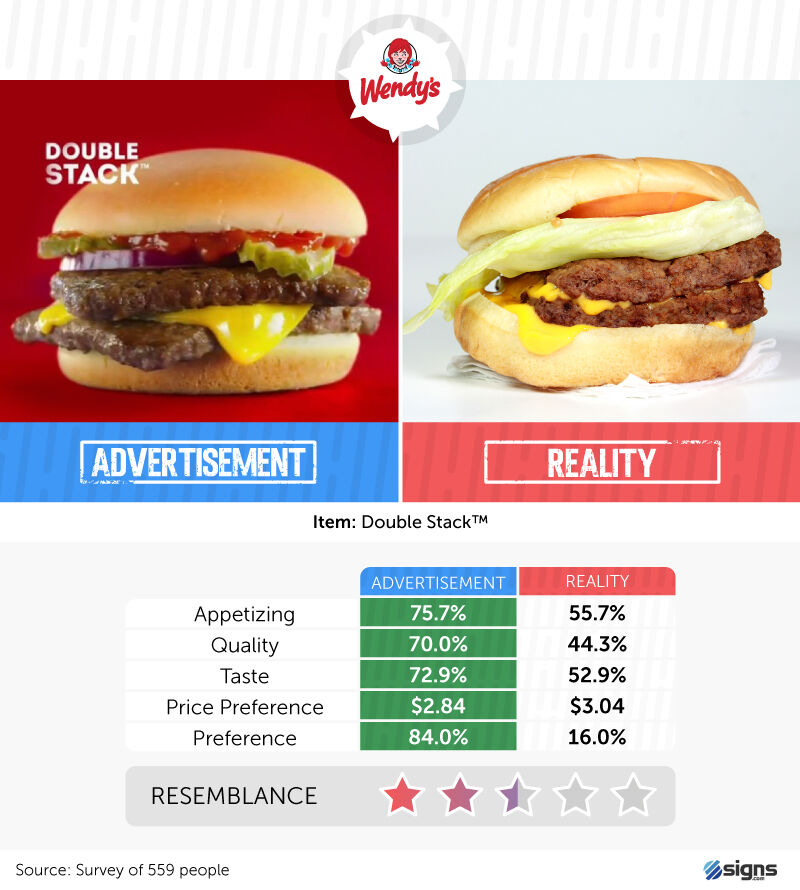
Wendy's often takes aim at its competitors' frozen patties, but its own burger didn't look too hot according to our respondents. The advertised Double Stack scored around 70 percent in appetizing, taste, and quality, but those percentages plunged when it came to the real image. Strangely, respondents were willing to pay about 20 cents more for the real version, despite their reservations about its appearance. Perhaps the inclusion of lettuce in the reality image shifted respondents' perceptions of scale in some way.
Cross-Brand Comparisons: Resemblance and Preference
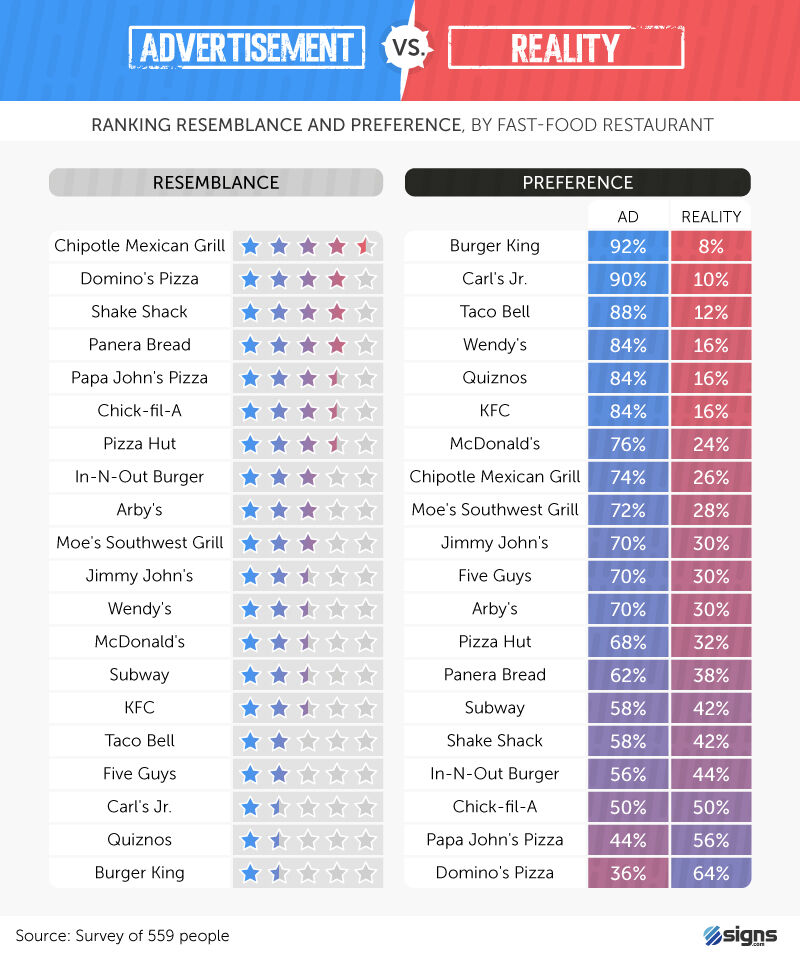
Having reviewed images of each chain's offerings individually, we can now study broader patterns in fast-food presentation. In a few cases, brands that received the poorest resemblance scores also had the most lopsided results in terms of respondents' preferences for the advertised versions of the products. Burger King, for example, tied for the lowest resemblance rating and had the smallest percentage of individuals preferring the real product image. Carl's Jr., which also scored just 1.5 stars for resemblance, had 10 percent of respondents who preferred the real picture.
As we mentioned earlier, two pizza brands, Papa John's and Domino's, were the only chains for which respondents found the real-item images more preferable than the ads. Chick-fil-A's real and advertised images divided our respondents evenly, and In-N-Out, Shake Shack, and Subway were among the least lopsided brands in this regard. Still, the overwhelming pattern is clear: We like what the ads showmore than what we are actually given.
Marketing vs. Reality: The Greatest Gaps
When we considered real-item images and ads for all 20 brands, certain companies seemed particularly willing to present manicured versions of their menus. With Chick-fil-A's original chicken sandwich, respondents found the ad 108 percent more appetizing than the real picture and perceived a nearly identical difference in quality. Burger King also had quite a large gap between the perceived quality of its burger in ads and the way it looked in reality. Unsurprisingly, respondents said they'd pay over $2 more, on average, if the item actually looked like they did in this company's ads.
In a few cases, however, the perceived value of the menu item didn't differ much between the ad and reality. For Carl's Jr. and Chipotle, for example, the differential amounted to a nickel or less. In the context of examining quality and price, it's important to note that many impoverished communities have few alternatives to fast food. In these cases, people likely buy food they know to be overpriced or inferior on occasion.
The Impact of Images
Our findings indicate just how loosely fast-food ads resemble the items they supposedly depict. For consumers, the corresponding conclusion is clear: When you're tempted by airbrushed images of sizzling meat and savory fries, remember that what you actually consume may be unrecognizable. Still, our data suggest that brands are usually successful in triggering our appetites through advertising, a testament to the persuasive power of images. Even when we know our food will pale in comparison to its idealized presentation, we hunger for it all the same. As long as this dynamic persists, unrealistic images of fast food will continue to fill our screens and public spaces.
Methodology
To accurately measure differences between advertisements and reality, we cultivated a list of fast-food restaurants and advertisements of food currently available on their menus. Our team from around the country purchased the food items shown in the advertisement and staged them to be as similar to the advertisement as possible, to reduce errors in judgment between reality and the advertisements based on the way the food was staged. We surveyed respondents on the perceived quality, taste, resemblance, preference, and what they would pay for the food items. Respondents were shown the reality first, followed by the advertisement.
Limitations
These food items were bought at an individual location, and the images of real food are not indicative of every location.
Sources
- https://www.usnews.com/news/health-care-news/articles/2018-05-22/study-teens-exposed-to-more-junk-food-ads-eat-more-junk-food
- https://www.cnn.com/2017/04/27/opinions/overeating-the-new-tobacco-opinion-sharma/index.html
- https://www.usatoday.com/story/money/2017/09/06/wheres-beef-arbys-finds-success-carnivores/621838001/
- https://www.investopedia.com/articles/markets/111015/mcdonalds-vs-burger-king-comparing-business-models.asp
- http://adage.com/article/special-report-super-bowl/qa-a-charlotte-mckinney-ashamed-carl-s-jr-super-bowl-ad/311975/
- https://www.eater.com/2018/4/2/17187976/chick-fil-a-growth-expansion-sales
- https://www.businessinsider.com/chipotle-queso-changes-to-come-ceo-says-2018-5
- http://www.latimes.com/business/la-fi-agenda-dominos-20170515-story.html
- https://www.inc.com/chris-matyszczyk/this-surprising-brand-is-now-americas-favorite-burger-chain-no-its-not-in-n-out-.html
- http://www.foxnews.com/food-drink/2018/06/29/why-in-n-out-burger-isnt-coming-to-east-coast.html
- https://www.cnbc.com/2018/09/06/kfc-mcdonalds-burger-king-pizza-hut-china.html
- https://www.usatoday.com/story/money/2018/07/29/mcdonalds-unveils-maccoin-celebrate-big-macs-50th-anniversary/844522002/
- https://www.businessinsider.com/the-bestselling-mcdonalds-menu-items-of-all-time-2018-2
- http://fortune.com/2017/05/19/americas-favorite-mexican-restaurant-revealed/
- https://www.bustle.com/p/pizza-huts-cheesy-bites-pizza-is-back-for-a-limited-time-it-looks-as-glorious-as-ever-9781025
- https://www.thrillist.com/news/nation/pizza-hut-60th-birthday-double-cheesy-crust-pan-pizza#
- https://www.denverpost.com/2018/06/11/quiznos-bought-by-california-company/
- https://www.eater.com/2017/1/5/14162804/shake-shack-raises-prices
- https://www.usatoday.com/story/money/2018/09/10/subway-5-footlong-going-away-but-paninis-may-their-way-exclusive/1206727002/
- https://www.tacobell.com/food/tacos/nacho-cheese-doritos-locos-tacos-supreme
- http://adage.com/article/cmo-strategy/spot-wendy-s-kicks-mcdonald-s-frozen-beef/314843/
Fair Use Statement
If you'd like to share our findings for noncommercial reuse with the fast foodies in your life, feel free to use our content on your own website. You'll need to include a link to this page, though, to credit our team for their hard work on this project.
About
Fascinated by the impact of advertisements on human psychology? Us too! Signs.com is a team of design, marketing and tech nerds providing customers with easy professional printing to decorate their homes and offices and grow their businesses. More than just custom signs, Signs.com offers superior customer service, an easy-to-use online design tool, and free design services to help make your logo, brand, and company as memorable as possible.


 Fastest Growing Private Companies in America
Fastest Growing Private Companies in America
